- Revenue Cycle Management
- COVID-19
- Reimbursement
- Diabetes Awareness Month
- Risk Management
- Patient Retention
- Staffing
- Medical Economics® 100th Anniversary
- Coding and documentation
- Business of Endocrinology
- Telehealth
- Physicians Financial News
- Cybersecurity
- Cardiovascular Clinical Consult
- Locum Tenens, brought to you by LocumLife®
- Weight Management
- Business of Women's Health
- Practice Efficiency
- Finance and Wealth
- EHRs
- Remote Patient Monitoring
- Sponsored Webinars
- Medical Technology
- Billing and collections
- Acute Pain Management
- Exclusive Content
- Value-based Care
- Business of Pediatrics
- Concierge Medicine 2.0 by Castle Connolly Private Health Partners
- Practice Growth
- Concierge Medicine
- Business of Cardiology
- Implementing the Topcon Ocular Telehealth Platform
- Malpractice
- Influenza
- Sexual Health
- Chronic Conditions
- Technology
- Legal and Policy
- Money
- Opinion
- Vaccines
- Practice Management
- Patient Relations
- Careers
Come to Poland But Don't Miss Gdansk
Gdansk, way at the "top" of Poland, er the North Pole, might be the perfect place for anyone interested in European history because the city the Germans once called Danzig has survived every challenge whether geographical, political, commercial, or historical.
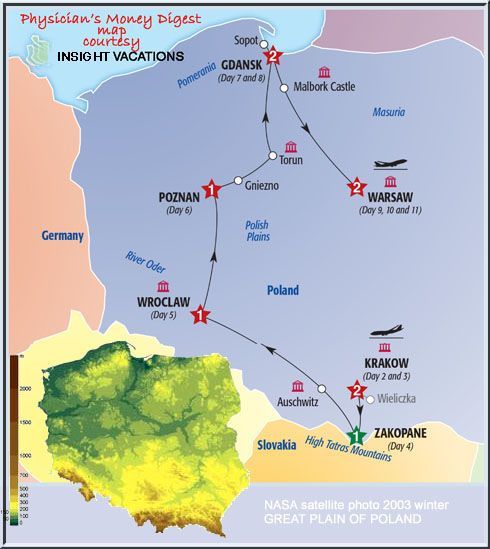
We have now spent the first five nights (six if you count the red-eye special from the United States) of our trip to Poland. We have four nights to go, the next two in Gdansk. Essentially we have traveled from Poland’s most southerly place, Zakotane, to its northern point on the Baltic coast, the Tri-Cities of Gdansk, Sopot, and Gdynia.

This map gives an idea of distances and locations of where we’ve been.
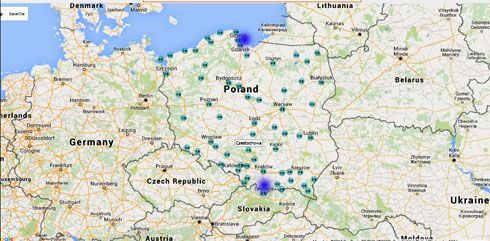
It might be convenient here to look at Poland’s geography on this Google map. Our most southern and northern points are marked with a blue dot. To Poland’s north lies Scandinavia. To the northeast, Lithuania, a longtime ally by monarchy marriage and a famous collaborator in the stunning reversal those two countries gave the Prussians at Grunwald in 1410. To the east, Belarus and Ukraine and, as always, the confusing posturing of Russia. To the south Slovakia and the Czech Republic. And finally to the west, Germany.
Poland’s vulnerability between the Russian communist empire to the east and Germany to the west may not have been understood by the wartime allied forces, but it surely was by our gruff Polish cab driver who picked us up on our arrival at Krakow airport the week before. “America never understood what she was getting into,” he grumped over his shoulder in fairly good English. “All this talk about nations. World War II was simply a war between Russia and Germany — and Poland, like all the rest of the world, simply got stuck in the way!”
History suggests our cabdriver’s explanation of all this and the collateral damage has some accuracy.
Gdansk, way at the “top” of Poland, er the North Pole, might be the perfect place for anyone interested in European history because the city the Germans once called Danzig has survived every challenge whether geographical, political, commercial, or historical.
It seems every time a war ended in Europe the victors didn’t quite know what to do with this splendid, but remote to the world, seaport — which opens central Europe and its frozen neighbors to the Baltic Sea. The peace committees hanging around the victors would just declare the port a “free zone.” That did not make life easy for this city on the mouth of the Motlawa River. It merely delayed the next war rather than not prevent it.
The name Motlawa was Prussian, the old Polish name was Gdania and as if on cue World War II started with a bang here on Sept. 29, 1939.
We vacate our coach in Nowy Port and gaze across the Kanal Portowy to Westerplatte itself. It’s a bit foggy but the Statue to the Defenders of Westerplatte, composed of 236 granite blocks, stands across the canal rising 82 feet high. Seven miles or so to the south on the esplanade of Stara Motlawa lie today’s restaurants using as their décor American icons like Brando and JFK and Marilyn and Elvis. It really is a small world.
The Westerplatte peninsula was an important defensive zone manned in 1939 by 200 crack Polish troops whose task was to hold on if attacked for 24 hours so that ground, air, and sea forces could relieve them. Such was the bravura of 20th century warfare. But the Nazis were from a different century and knew the value of propaganda. They showed the world reports and images of Polish military (Nazis dressed in Polish uniforms) attacking a German border town and killing German soldiers (actually concentration camp victims dressed in German uniforms) said by the Nazis they had been killed by Poles. This gave them the authority to attack Westerplatte. Historians have long felt the first shots of World War II occurred here from the barrels of the German battleship Schleiswig Holsten (“visiting Gdansk on a goodwill mission!”) but post war documents show the first shots came from a German garrison on a gun emplacement halfway up the lighthouse.

Walking back to our Radisson Blu hotel we noticed the small museum of the Historical Zone, the free City of Danzig. It showed what the city was like a hundred years ago at the turn of the century: kitchens maybe before the era of electrical appliances, when frugal housewives would polish the silverware by which they might be judged. There is, of course, history elsewhere in the city from iron limb restraints near the Amber Museum to a photograph passed around in our coach showing a confrontation in 1981 when a member of Solidarity stood before the communist tanks in a scene not unlike that in the Tiananmen Square protests in China in 1989.

In December 1970 when the shipyard workers struck to protest poor working conditions, and the army fired on the protestors killing at least 44, the communist world was shaken. That it remained a huge event is shown by the impressive 138 feet tall, Monument to the Fallen Shipyard Workers that rose in 1980.
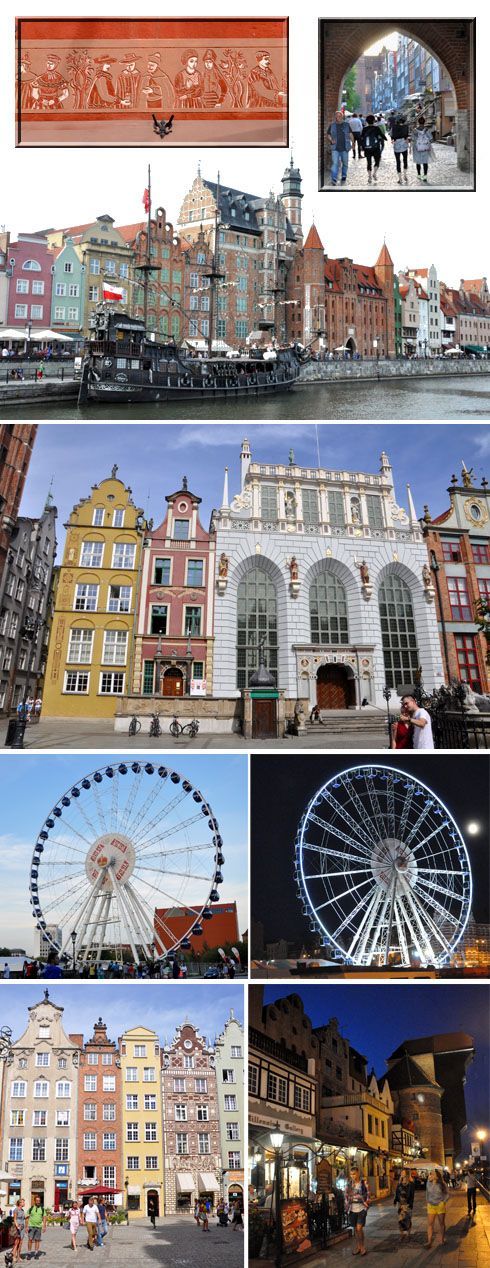
Walking around Gdansk brings you past signs on walls; archways that lead into colorful streets; the ship Black Pearl, a “cruise ship stylized on a 16th century galleon”; and the gorgeous buildings on the main drag Dlugi Targ. Walk day or night: this city is ready when you are.
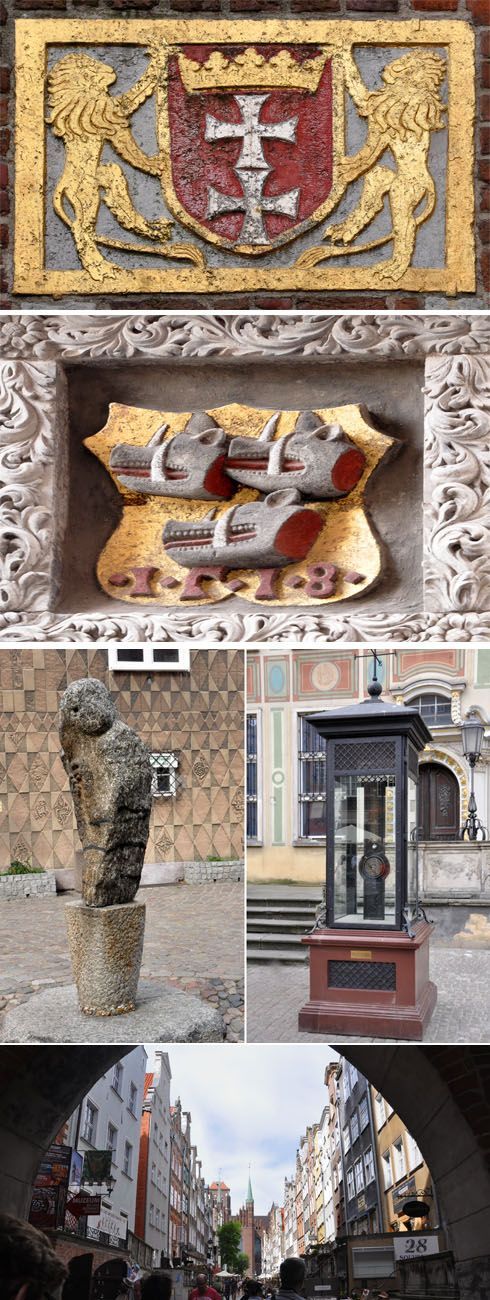
Signs show the coat of arms of Gdansk, and two interesting tall tributes: the one on the left is a religious one involving the pelican that we will explain when we go to Malbork Castle in two days. And a glass case showing an instrument with a dial. This is a tip of the hat to favorite son Daniel Gabriel Fahrenheit born here in 1686 who, after developing the temperature scale named after him, invented the mercury-in-glass thermometer. Another archway showing our route to the Amber Museum.
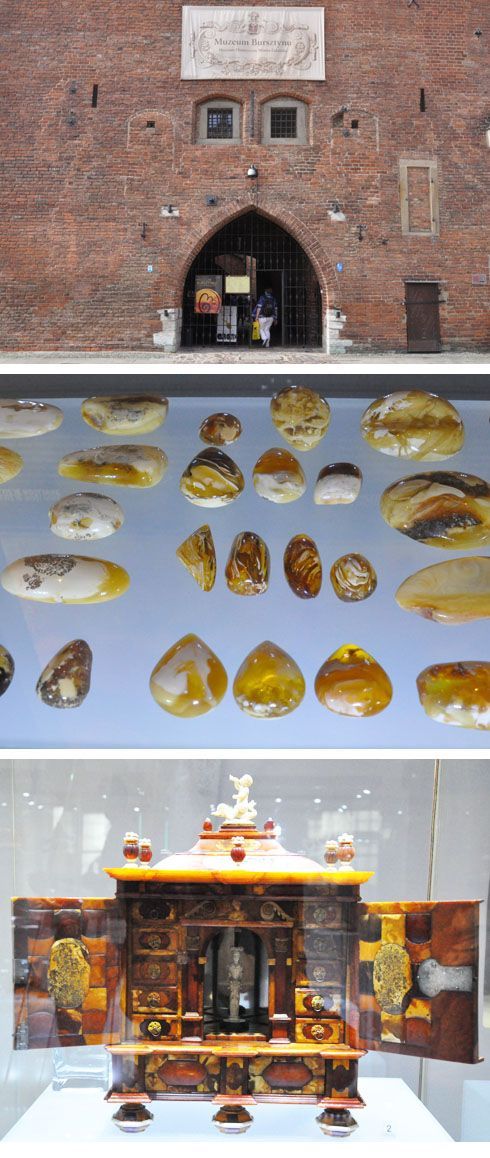
The Amber museum is now housed in the medieval building once occupied by the Prison Tower and Torture Chamber. It does a good job despite its stairs and small rooms to tell the tale of the Amber trail and the history of Baltic amber. There was apparently a requirement to exit through the Torture Museum but we pretended to misunderstand and avoided that scenario.

Amber, fossilized pine resin, commonly found on the Baltic shore was especially prized in the Middle Ages. Some of the specimens on show are about the size of a semi-deflated Patriots football. Others show the desirable inclusions of insects. A map attempts to reveal the range of exports from the Baltic to central Europe where the unsophisticated believed amber had healing properties if rubbed on the skin.
We have a stop before leaving for Warsaw: Malbork, the largest brick castle in Europe.
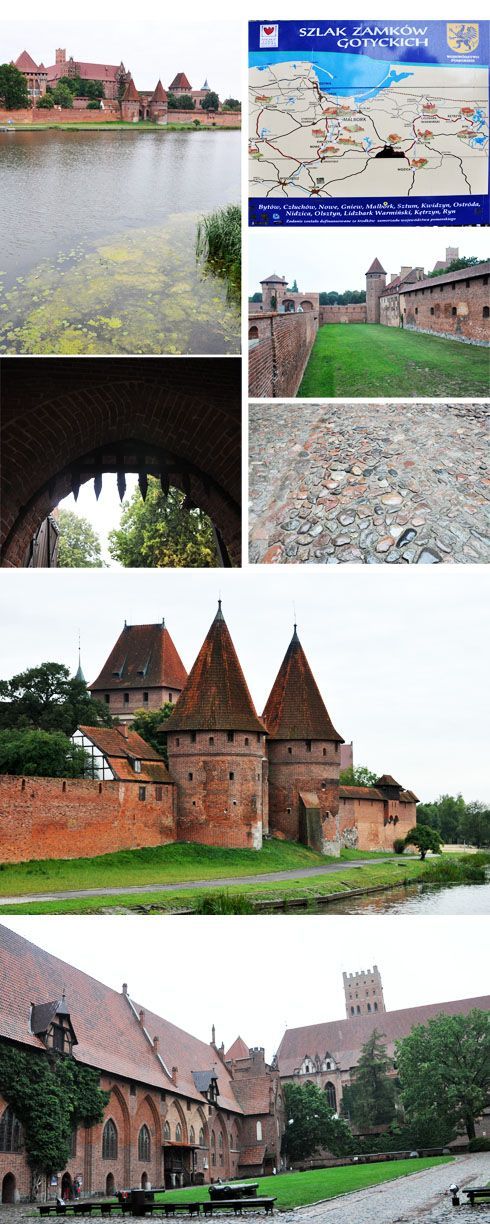
Built with 60 million bricks and the most fortified castle on the continent, Malbork stands on 50 acres knowing it will never lose out on any Guinness record challenge. Although its invulnerability was helped by a moat the size of a lake beyond swamplands it also presented a series of entrance challenges; there was no single way of getting in. A map on a board shows how close the many supporting castles were. The Grandmaster of the Teutonic Knights controlled 120 castles
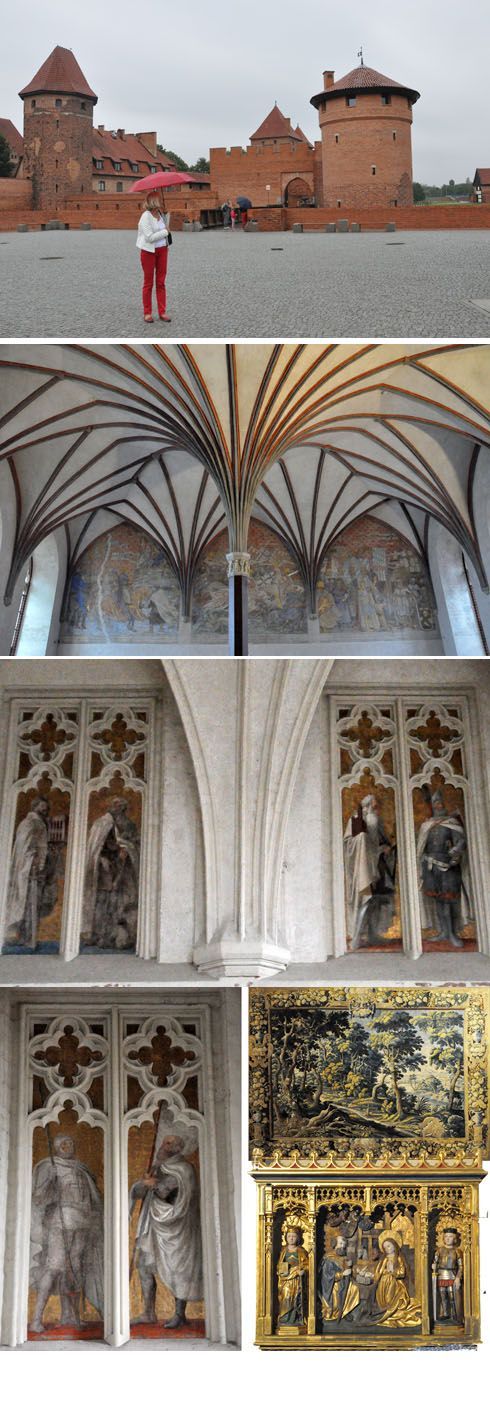
The castle was a grand production and the interior shows it.

Some of the Knights. A reference to the Pelican: An ancient legend that preceded Christianity was that in times of famine the mother pelican would wound her own breast to feed blood to her young to prevent starvation. The early Christians adapted this to symbolize how Jesus gave His life for their redemption.
And now about 220 miles ahead lies the capital of Poland, Warsaw.
Photography by the authors.
The Andersons, who live in San Diego, are the resident travel & cruise columnists for Physician's Money Digest. Nancy is a former nursing educator, Eric a retired MD. The one-time president of the New Hampshire Academy of Family Physicians, Eric is the only physician in the Society of American Travel Writers. He has also written five books, the last called The Man Who Cried Orange: Stories from a Doctor's Life.
